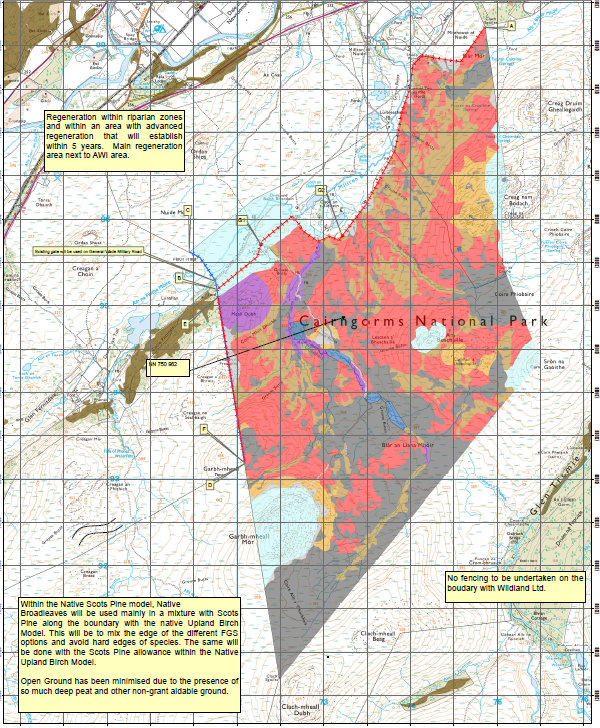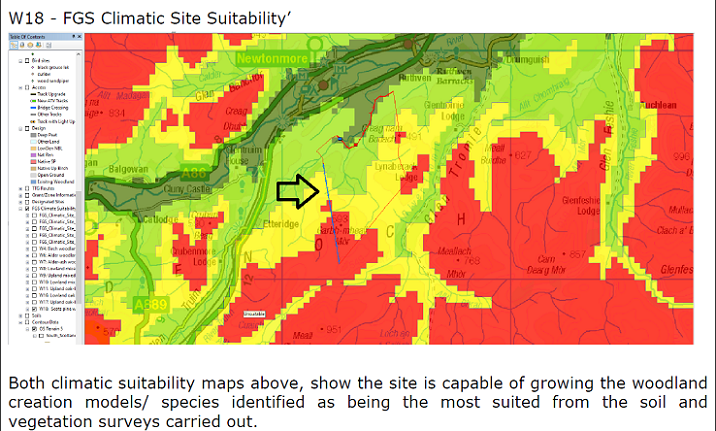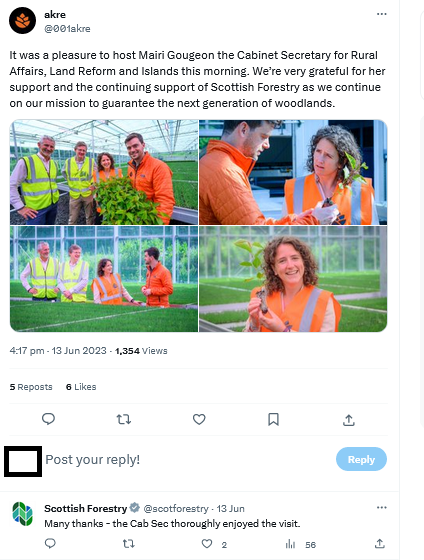
Scottish Forestry has revealed in correspondence that it has awarded £2,559,303.91 (£200k more than I had thought) to Abrdn for tree planting at Far Ralia. It also sent a copy of the approved plan (above) which appears the same as that issued for consultation. Scottish Forestry has therefore approved the plans submitted on behalf of Abrdn by Akre/SAC consulting without further amendment despite a number of people submitting objections.
Two weeks ago (see here) I explained why these plans are an environmental disaster: rather than offsetting carbon they will release it into the atmosphere for the foreseeable future (as a consequence of trees being planted on peat) and result in native tree plantations in areas where trees are regenerating naturally at present and natural woodland would establish itself if given time. Scottish Forestry, ie we the public, are also paying for a duplicate deer fence along the boundary with the Phoines estate, stock fencing to keep out sheep from the Ralia Estate which sold the land to Abrdn and over half a million vole guards.
What I didn’t mention in that post was much of the £2.599,303.91 will be spent on land that Scottish Forestry has assessed as being “marginal” for forestry and in ways that are contrary to its own guidance.
Land marginal for forestry
The land at Far Ralia is above 280m in height and is generally wet, hence in part why wet heath and peat bog has developed over much of it.

According to Scottish Forestry’s map viewer (link here) well over half of the land Abrdn bought at Far Ralia is either unsuitable (red) or marginal (yellow) for growing trees but despite that they appear to be funding Abrdn to plant 842.54 out of the 1467.40ha. Most of the areas that are not being planted are either over c450m or covered in peat more than 50cm thick.
If you compare the approved plan above with the screenshot below it you can see that Scottish Forestry have approved the planting of significant numbers of Scots Pine in areas which they themselves have classified as being marginal for this species. This is contrary to their own woodland creation guidance for landowners (see here) which states:
“If the species you intended to plant is not shown as ‘very suitable’ or ‘suitable’ in terms of climatic
suitability, further investigation would be required by a forestry consultant and it is unlikely that we will
approve your application”.
The forestry consultants in this case, SAC and Akre, have asserted “the site is capable of growing the woodland creation models”. That is not the same as showing it it sensible to site a native tree plantation here. The guidance on climatic suitability is there for a reason. Trees tend to not grow well on elevated wet sites and planted trees are at high risk of being blown over. So why has Scottish Forestry in this case chosen to ignore those facts and grant Abrdn £2.56m?
More examples of Scottish Forestry ignoring its own guidance at Far Ralia
As part of the plans Abrdn is proposing to use “approximately 556,500 vole guards to protect the trees it plants. It is not clear whether these are plastic or not but Scottish Forestry’s guidance to land managers on the Woodland Grant Scheme, cited above, states:
“Vole guards should only be used where there are high vole populations on site and can be used in addition to deer fencing”.
Abrdn’s woodland grant application form to Scottish Forestry contains no information about the size of the vole populations at Far Ralia but the fact that an area of woodland regenerating naturally without them indicates vole numbers are low. Paying for vole guards therefore fails to meet Scottish Forestry’s own criteria and if they are plastic will cause even more damage to the natural environment.
Scottish Forestry has also had guidance since 2000on planting on peatland (see here) which has a section on “Creating and managing a peatland edge woodland”. This appears applicable to to Far Ralia where there are large areas of deep peat around which narrow buffer zones are proposed:
“A typical specification for peatland edge woodland would be low density planting comprising 50%
planted, 50% open ground. It would be restocked with native species within their natural range, in groups with spacing no greater than 1.5m between stems and no less than 500 stems per gross hectare. Creating a priority native woodland habitat is desirable”.
Comment: the map above includes a statement that the amount of open ground has been minimised to maximise the amount of grant aid; trees at Ralia Ralia will not be planted in groups but plantation style; and scrub woodland species like juniper and willows that would grow naturally on parts of Far Ralia are absent from the proposals. At Far Ralia “Stocking density at the time of planting will be 1750 stems per ha for Native Scots Pine Model”, ie three times the minimium recommended.
The guidance goes on:
“This model of woodland might be achieved by, for example:
• Taking advantage of natural regeneration whenever acceptable results (stocking and
species mix) are likely to be achieved within a reasonable timescale.
• Where planting is necessary, matching locally native tree and shrub species to site
conditions. Mimicking natural patterns of plant spacing and distribution will encourage these
native stands to become semi-natural in the long-term.
• Allowing an element of non-native natural regeneration on sites with an internal forest
boundary to help secure a positive carbon balance, provided this regeneration does not
compromise the growth of native planting on the site.
• Using minimum cultivation needed to ensure satisfactory establishment, and retaining little
or no artificial drainage.
• Being located where it will provide a gradation from high forest to areas of existing or
restored peatland, but without transgressing onto associated buffer zones (particularly for
designated or high value peatland sites, e.g. those used for wading birds).
• Maintaining deer populations at less than 5 per square kilometre”
Little to none of this appears to have been applied at Far Ralia because of Abrdn’s wish to hoover up as much grant as possible (deer numbers are almost certainly well below 5km because of what Wildland Ltd is doing in Glen Tromie but what Abrdn is proposing to do to help with this is still unknown). I am pleased to say that following my last post the Manager from Abrdn has agreed to meet with myself and others onsite with Renwick Drysdale from Akre Trees some time in September. I look forward to a discussion with them about this guidance and how their proposals fit.
Why is Scottish Forestry ignoring their own guidance and financing destructive forestry?
Scottish Forestry’s decision to approve £2.56m grant for Far Ralia appears to have been determined by planting targets not the science.
At COP 26 the Scottish Government announcement “ambitious” new tree planting targets, upping the target for new woodland from 12,000 to 18,000ha a year and pumping an additional £150m into tree planting including increasing the capacity of nurseries (see here). These planting targets were set without any consideration of other objectives, such peatland restoration, or other factors impacting on woodland, most notably muirburn and grazing..
Scottish Forestry has been under pressure from the Scottish Government to meet these targets so a scheme like Far Ralia, which promises to deliver c550,000 out of the annual target of 30m trees and 842ha out of the target 18,000 ha of land planted, is hard to resist. Never mind if it is sensible either in forestry terms (planting on marginal sites) or in carbon terms (planting on peat). Never mind too that the Cairngorms National Park Authority has a presumption in favour of woodland expansion by natural regeneration and the finest example of that happening is just over the watershed on land owned by Wildland Ltd.
In the case of Far Ralia, however, there is also a new tree nursery involved, Akre Trees, which provided an opportunity for a double tick for Scottish Government Ministers.
In April Scottish Forestry issued a license to Akre/Kilree Trees (see here) to fell 3.67 of native broadleaved woodland to enable Akre to construct a hardening off area for its nursery. The 4.99 ha of compensatory planting will take years to re-absorb the carbon released into the atmosphere, just like Far Ralia.
Akre Trees, as I have previously explained (see here) is owned and managed by Renwick Drysdale whose father had been or still is a trustee of the Drumochter and Ralia estate which sold the land to Abrdn. According to the felling license the nursery aims is to grow 9 million trees a year so the 550,000 trees being provided to Far Ralia will help meet their targets too.
In June, just a few weeks before Scottish Forestry decided the Far Ralia Woodland Grant application the Scottish Government Minister responsible for forestry, Mairi Gougeon, happened to visit the Akre tree nursery:

It is not clear whether the visit by Mairi Gougeon was set up by Akre Trees or Scottish Forestry but either way once this visit had happened the decision on Abrdn’s woodland grant application appears to have been a foregone conclusion.
What Far Ralia illustrates is how the nature restoration and carbon offsetting agendas have been hijacked by vested interests and we need politicians, advisers and board members who are prepared to challenge this.

If this isn’t something for Audit Scotland to investigate I don’t know what is
Every new post on this disgraceful scheme ( and those on the mismanagement of nearby Glen Banchor) fill me with sadness and despair.
I have known this area for over forty years ,my most recent visit to Ralia being last year ( and Glen Banchor this past April ).
Being unsure, at this time, if i will ever get back to the area , makes these changes somehow much harder to accept.
Along the track from the old Wade bridge is a memorial to a long serving Head Keeper, leaving apart the problems with Grouse shooting, i shudder to think what his opinions would be.
Nobody in power listens, understands , or cares, they never have and never will. Lip service is paid , then
it is a race to be first to backtrack , or water down protections ètc.
Near the boundary with Wildland is a scattering of small crags, on one of these grows a Rowan that flowers beautifully, it is lovely to sit by in spring , looking over to Glen Tromie, and if i do not get back that is a memory i will keep.
ABRDN also invests in coal, oil and gas.
For example – even Adani !!
https://www.thenational.scot/news/23315451.abrdn-scots-capital-firm-huge-investment-embattled-coal-giant/